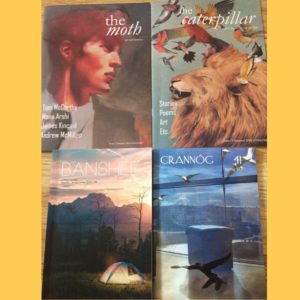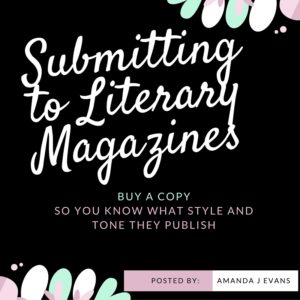Over the past two months, I have been submitting to literary magazines and taking more of an interested in my personal writing. There is nothing nicer than seeing your name in print but it’s not as easy as you think. Each literary magazine will have their own editor or editors and you have to impress them with your writing.
I started submitting pieces in April and at first, I was doing what I call a “blind submission”. I had no idea what the magazine was about. I hadn’t read it, and of course, I had no idea what style or tone of writing they published. All I was doing was looking at upcoming deadlines on Duotrope, picking a poem or short story, and sending it off. Not the best way to do things but in my naivety, I didn’t know any better.
As I began researching and reading articles about submitting to literary magazines I noticed that it was stated time and time again, that you should read the magazines. Now that to me meant spending money and it wasn’t something I was comfortable doing. Fast forward to my first rejection letter and I realised just how important this advice was.
 In the past month, I have purchased a number of literary magazines, especially the ones I would like to see my work featured in. I’ve bought Banshee, Crannog, The Moth, and The Caterpillar. I’m sure I ordered The Penny Dreadful as well but that has arrived yet.
In the past month, I have purchased a number of literary magazines, especially the ones I would like to see my work featured in. I’ve bought Banshee, Crannog, The Moth, and The Caterpillar. I’m sure I ordered The Penny Dreadful as well but that has arrived yet.
I was very surprised when they arrived through my door. What I thought were magazines are actually small books. A quick scan through them reinforced my desire to have my name added to the authors being featured. Reading them was a real eye opener too. As I read the poems published in each of these books it quickly dawned on me that a lot of my poems weren’t like any featured. These contemporary poems were so different and there were a few that actually left me baffled. Just last night I sat with my husband reading through The Moth. The poems in this were confusing and the majority of them made no sense to me. I was disappointed to say that least and I even read some of them out loud to my husband to see what he thought. His reaction was, “so you can just write gibberish.” He didn’t understand the poems either and it made me realise that I have a lot more to learn about the art of contemporary poetry if I wish to feature in this magazine. Some of the poems did have an underlying message that on a second or third read I was able to see, but some just went way over my head and left me confused.
It wasn’t all bad though because I now have a good understanding of the style and tone of the work The Moth publish. Their other publication “The Caterpillar” is for younger readers aged 7 – 11 and the poems in this were very much my style. I understood them, there were humorous, and I knew some of my pieces fit perfectly with this magazine.
If I learned anything this weekend it was the importance of taking my dream of publication in literary magazines seriously. Spending money to educate myself is not a waste and it really was helpful. Even after reading submission guidelines, you have no idea of the style or tone of the magazine and reading one or two of their online poems does not give you the information you need. You really do need to get the print edition. Lesson learned and very much appreciated. I am now more aware of my own style and the magazines that suit my personal style. If I want to see my work in “The Moth”, I need to further my skills and learn more about writing contemporary style. I also need to brush up on descriptive skills, synonyms, and bringing more metaphors into my work. It might take a while but I have added it to my goal list for 2016 and intend to see it happen.
Below I have included a list of the literary journals that I want to have my work published in.
My Top 12 Literary Journals for Poetry and Short Stories
- The Moth – The Moth is a quarterly arts and literature magazine featuring poetry, short fiction, and pictures by established and up and coming writers and artists from Ireland and abroad.
- The Caterpillar – The Caterpillar is the younger sibling of The Moth, a magazine of poems and stories and art for grown-ups. The Caterpillar is for kids between the ages of 7 and 11(ish), though grown-ups are bound to like it too. It appears four times a year ‒ in March, June, September, and December ‒ and, like The Moth ‒ is jam-packed full of new artworks.
- Crannog – Crannóg is a Galway based magazine published by Galway writers workshop three times a year, in February, June, and October. Crannóg publishes poetry and short stories.
- Banshee – Banshee is a new print journal of exciting, accessible, contemporary writing from Ireland and around the world. We’re interested in a variety of formats: short stories, flash fiction, poems, and personal essays. We publish twice a year, in spring and autumn.
- Stinging Fly – The Stinging Fly was first published in 1998,·it was edited by founding editors Aoife Kavanagh and Declan Meade. Published three times yearly, the magazine provides a forum for the very best new Irish and international prose and poetry.
- Penny Dreadful – The Penny Dreadful hopes to probe the nooks and crannies of the cavities of fiction, poetry and every form of literature. It does not have stars in its weeping eyes nor a particularly idealistic soul. There is only the void.
- The Dublin Review – The Dublin Review is a quarterly magazine of essays, reportage, autobiography, travel writing, criticism, and fiction. The magazine is presented in book form with minimal design, it was first published in 2002 by Brendan Barrington.
- The New Yorker – The New Yorker is a weekly magazine offering a signature mix of reporting and commentary on politics, international affairs, popular culture and the arts, science and technology, and business, along with fiction, poetry, humour, and cartoons. The magazine is available in print at newsstands and by subscription.
- Poetry Ireland Review – Poetry Ireland Review is a highly-regarded journal of poetry. Published three times a year, the Review includes the work of both emerging and established Irish and international poets, essayists, critics and visual artists.
- Bare Fiction Magazine – Bare Fiction was set up to promote new writing in all forms through performance, digital representation, and publication. We offer a platform for new creative writing across poetry, fiction and plays to encourage writers who are testing their boundaries to stretch themselves creatively. An 80-page A4 publication comprising of new work in the genres of poetry, fiction, and plays, including articles and reviews of writing along with interviews with practitioners that is entirely produced by our team of volunteer editors and contributors.
- Skylight 47 – The first issue of Skylight 47 was published in January 2013 to celebrate ten years of Galway’s Over The Edge poetry readings in the City Library. Their newspaper format allows them room to spread their wings and gives the work of the contributor’s space to breathe.
I hope you enjoy this list of Literary Journals and if you do plan on sending in a submission, be sure to do your research, read their online poems and stories, and buy a copy to read. This will really help your chances of having your work accepted.
Until next time,
Amanda
Amanda J Evans is an award-winning Irish author and writing coach. Amanda writes adult romance that often crosses into paranormal and fantasy. Growing up with heroes like Luke Skywalker and Indiana Jones, her stories centre on good versus evil with a splice of love and magic thrown in too. Her books have all won awards and her novella, Hear Me Cry, won the Book of the Year Award at the Dublin Writers Conference 2018. Amanda is also the author of Surviving Suicide: A Memoir from Those Death Left Behind, published in 2012.


Very interesting indeed. It’s a similar situation with art galleries. I’m considering in submitting my seascapes but something I was told by an artist was to do the research first as not every gallery would want it, so to save face and save disappointment I’ll research first and then approach those that seem to have same standard of artists with perhaps seascape themes. I’m looking to write a children’s nursery rhyme story book so it’s interesting reading your blog re magazines – thought proving indeed
Thanks Joan,
It really is very helpful to look at what is being published because it gives you an idea of how your work will fit. If you are doing a children’s story book you should check out http://www.doloreskeaveney.com/ She paints all the pictures for her books. She is coming to do a talk with my writers group this week and I’m really looking forward to it.
Amanda
Thank you Amanda for sharing the list of magazines with us. I have been thinking that I should start to write short stories before I try to write the whole book. I do have few pages of the book written and I find it relaxing to work on it but it is gonna take me many years to finish it. For now I am happy enough to write a blog posts and learn to use the English language to express my thoughts. I think its not far from writing little stories. I will keep an eye on magazines and maybe submit something. You know the same apply to photographs.. Yesterday I joined photo challenge on wordpress for the first time with my photo of a unicorn :-). Have you seen their writting challenge?
Thanks Petra, and best of luck with the stories. Have you looked for journals in your native language? That could be a good idea too. Best of luck with the photo challenge too. I don’t paint, draw, or take photos but it might be something some of my artist friends might enjoy.
Amanda